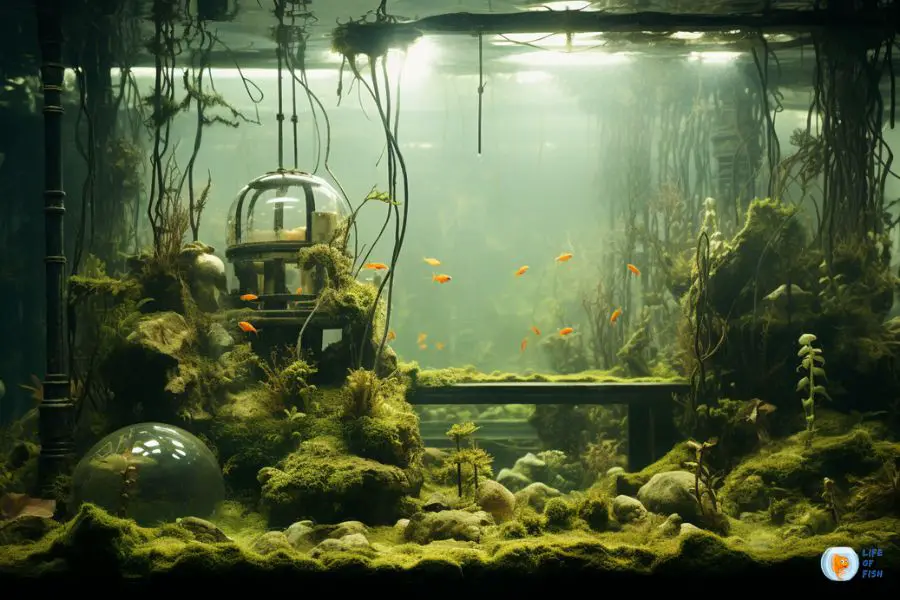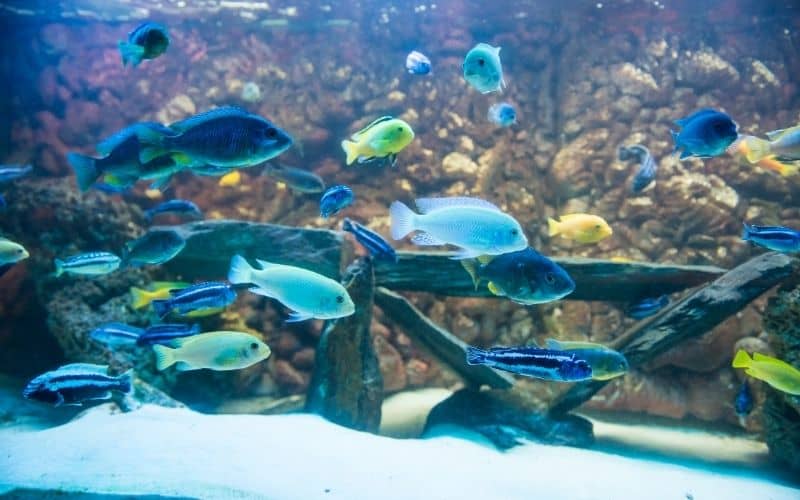High Nitrates in Freshwater Aquariums is an ongoing struggle for many freshwater aquarium owners.

Despite diligent tank maintenance and water changes, some systems chronically test off the charts for nitrates.
Levels over 40 ppm can fuel algae growth, stress fish, and cause long-term health issues. Tracing the source of excess nitrates and reducing their production is key to creating a safe habitat.
With some adjustments to feeding, stocking, plants, and filtration, aquarists can get nitrates under control.
Understanding the Nitrogen Cycle
Jump To
To tackle troublesome nitrates, start with some background on the nitrogen cycle in tanks. This is the process by which nitrogen compounds change form in a contained aquatic environment.
Fish waste, uneaten food, and dead plant matter release ammonia into the water, which is highly toxic.
Friendly bacteria in the filter media convert ammonia first into nitrite, then into nitrate. Changing nitrate to nitrogen gas requires anaerobic bacteria deep in substrates.
Nitrate is the least toxic nitrogen compound. But without biological filtration to remove it, nitrate accumulates through the byproducts of the nitrogen cycle.
Keeping nitrates in check depends on limiting excess inputs and increasing beneficial bacterial colonization.
Impacts of High Nitrates on Freshwater Systems
While less acutely dangerous than ammonia and nitrite spikes, chronic high nitrates cause a range of problems including:
- Accelerated algae growth, particularly brown diatoms and green water algae
- Increased bacterial and fungal infections in fish
- Potential long-term kidney and liver damage
- Reduced growth rates in fish
- Decreased spawning and fertility
- Stress hampering the immune system
Levels above 40 ppm are widely considered cause for concern. Even small increments make a difference, with every reduction of 5 ppm lowering risks. Getting nitrates to 20 ppm or under should be the goal for health.
Common Causes of High Nitrates in Freshwater Aquariums
Many factors can send nitrates soaring and make removing them difficult. Typical causes include:
Overstocking
Fish waste and respiration directly increase nitrate generation. Too many or oversized fish overload the biofilter capacity.
Overfeeding
Excess food leads to more ammonia production during decay, which filters down to nitrates. Feeding more than fish can eat in 3-5 minutes fouls water.
Insufficient Plant Growth
Plants uptake nitrate for growth. Without enough healthy plants, this nitrate removal system falters. Slow growers like Anubias have minimal effect.
Inadequate Water Changes
Diluting nitrates through partial water swaps is crucial. Change should replace 25-50% of the total volume weekly, depending on stocking.
Filter Issues
Insufficient bacterial colonies, clogged media, or too-strong water flow hamper the nitrogen cycle. Filters require cleaning and flow adjustment.
Excess Organics
Dead leaves, fish waste, and debris increase nitrogenous breakdown products. Siphoning the substrate and pruning decaying plant matter limits organic buildup.
Pinpointing the factors driving high nitrate concentrations in a specific aquarium makes solving them more targeted.

Improving Nitrate Removal Techniques
Once the nitrate sources are identified, improving removal techniques can gradually reduce levels and keep them controlled. Helpful methods include:
Large, Frequent Water Changes
This is the fastest way to lower nitrates in the short term. Change at least 30% twice per week until nitrates drop below 20 ppm.
Add Fast-Growing Stem Plants
Plant corners densely with fast-growing stems like hornwort, water sprite, and Hygrophila. These soak up nitrate rapidly.
Clean Filter Media
Rinse filter media in old tank water biweekly to prevent clogging and maintain high bacterial counts.
Use Chemical Media
Add nitrate-absorbing chemical filter media like ion exchange resins or premium activated carbon to filter cartridges.
Improve Oxygenation
Maximize surface rippling, add air stones, and improve flow to maintain high DO. This facilitates aerobic bacterial nitrate processing.
Limit Lighting Duration
Excess light fuels algae, dying back and decaying into nitrate. Never leave lights on over 8 hours daily.
Clean Substrate
Use gravel vacuums to remove sunken organics during water changes. Spot clean driftwood, rocks, and decor.
Test Source Water
Well water high in nitrates requires pretreatment before use. Aeration and water softeners can help remove nitrate.
Persistence pays off when chipping away at excessive nitrate levels. As each method takes effect, numbers drop steadily into the target range.
Long-Term Prevention of Nitrate Buildup
Preventing spikes from recurring requires vigilance and upkeep with the tank ecosystem. Good long-term prevention habits include:
- Stock conservatively, allowing 2-3 gallons per inch of small fish.
- Feed no more than fish can consume within 2 minutes, once or twice daily.
- Establish a heavily planted tank using floating species to increase biomass.
- Choose a quality canister filter sized for the tank and clean it monthly.
- Invest in an efficient water changing system and gravel vacuum.
- Test water parameters including nitrate every 1-2 weeks.
- Remove decaying plant matter and trim back excessive growths.
- Use phosphate-absorbing filter media to limit algae growth.
- Quarantine new fish 4+ weeks to prevent import of pathogens.
The key to maintaining aquarium equilibrium is balance. Stability takes time but rewards the diligent aquarist with a thriving ecosystem. Do not get discouraged; bring nitrates down step-by-step and they will stabilize.
Read Next:
Do Bottled Bacteria Really Boost Your Aquarium Cycle?
How to Feed Your Fish When You Go On Vacation
